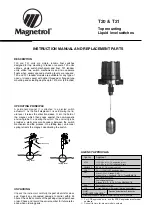
CHAPTER 5: THE CLI AND PROTOCOL MONITOR
THE CLI AND PROTOCOL MONITOR
MULTINET4 MULTI-PORT SERIAL SERVER & MANAGED SWITCH – INSTRUCTION MANUAL
5–11
5.2.2.6 The monitor Command
The monitor command is used to configure monitoring on a per-port basis and also to
start the monitoring process.
Note that the actual monitoring process can only be active for one port at a time.
The Protocol Monitor
The Protocol Monitor enables you to specify an Ethernet, serial, or WAN port for a detailed
view of the data being sent and received. You can customize your real time report as to the
protocol to observe, source and destination IP or MAC address or port, and display format.
Starting the Protocol Monitor
Start the protocol monitor by specifying a port to be monitored - in this example Ethernet
port 3. Enter the following command at the
MN4#
prompt:
MN4
#
monitor e3
This command will result in the display of a monitor mode prompt:
MN4
(monitor)#
When the
MN4(monitor)#
prompt is displayed you can enter any of the commands in the
Protocol Monitor command set to control the display of information on Ethernet port 3.
After you have configured the display to show the type and format of information you
want, you begin the display of information with the
start
command. While you are in
monitor mode you have exclusive access to the monitor feature.
The following example illustrates three configuration commands given in monitor mode
followed by the
start
command. This produces the
Monitor Started
message that
confirms that monitoring has begun:
MN4
(monitor)#
filter display ip
MN4
(monitor)#
filter linenum 4
MN4
(monitor)#
set mode terse
MN4
(monitor)#
start
Monitor Started
You can also configure and start the Protocol Monitor from the
MN4#
prompt by preceding
each command with
monitor
and the ID of the port to be monitored. The example below
executes the same commands as the previous example but does so from the basic
MN4#
prompt rather than the monitor mode (
MN4(monitor)#)
prompt:
Table 5–8: CLI log Commands
Command
Synopsis
Description
delete
delete
filename
Delete the log file specified by
filename
.
dump
dump
filename
Display the contents of the log file specified by
filename
.
show
show
List the filenames, sizes, and status of available log files.
















































